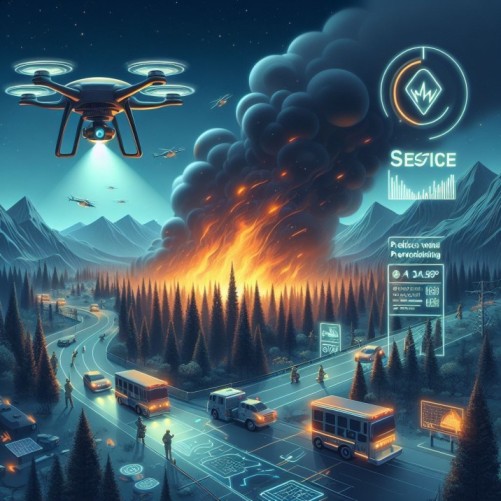Wildfires are raging across the globe at an alarming rate, leaving devastation in their wake. In 2021 alone, over 15 million acres were scorched in the United States, destroying thousands of homes and endangering countless lives. But what if technology could sense these disasters before the first spark? An innovative AI system from SAIC aims to make this a reality.
Thesis Statement
This article will explore how SAIC, a leader in developing cutting-edge technology integrations, has pioneered an artificial intelligence system that can predict and prevent wildfires through data analysis. Their groundbreaking AI has the potential to revolutionize wildfire management and stop blazes before they even ignite.
The Growing Threat of Wildfires
Wildfires have become a global menace, wreaking havoc across diverse geographies and climates. Raging out of control, these fast-spreading infernos put human lives, property, forests and wildlife at immense risk.
Global Problem
- Wildfires are dramatically increasing worldwide due to climate change, threatening devastation on every continent.
- Extreme weather events like heatwaves and drought catalyze uncontrolled blazes.
- Over 108,000 wildfires occurred globally in 2021, burning millions of acres of land.
- Rising average temperatures and drier conditions proliferate fire risks.
Impact on Pakistan
- Pakistan faces acute challenges from surging wildfires, especially in the Balochistan province.
- Over 5,000 fires raged through Pakistan in 2022, 3 times more than previous years.
- Lack of rain, severe heat waves and parched forests intensified the fires.
- Wildfires engulfed over 100,000 acres of land in Balochistan alone, causing fatalities and economic losses.
Limitations of Traditional Methods
- Manual monitoring of fire-prone areas is inefficient and reactive.
- Responding only after wildfires start allows them to spread rapidly.
- Lack of predictive capabilities makes preemptive action impossible.
- Resource allocation is challenging without advance warning about highest risk areas.
Enter the AI Hero: SAIC’s Technology
SAIC’s artificial intelligence system is engineered to study diverse datasets and derive actionable insights to predict and prevent wildfires like never before.
The Core of the AI System
- Collects and processes volumes of multi-disciplinary data related to wildfire risks.
- Employs complex algorithms to analyze the aggregated data.
- Builds predictive models to identify high-risk areas through pattern recognition.
- Translates predictions into prevention by alerting authorities.
Data Sources
- Satellites: Thermal imaging, vegetation moisture data
- Weather: Temperature, rainfall, humidity, wind patterns
- Historical: Fire incident logs, spread patterns
- Real-time: Sensors, cameras, field observations
Predictive Power
- Pinpoints locations with highest probability of fire ignition.
- Forecasts how fires may spread based on fuel, weather, terrain.
- Evaluates the scope and severity of potential wildfires.
- Continuously updates predictions with new data.
Proactive Prevention
- Early warning system for officials to allocate resources.
- Targeted fire breaks in predicted high-risk zones.
- Strategic resource pre-deployment to likely ignition points.
- Dynamic recommendations to neutralize emerging threats.
Case Studies: AI in Action
SAIC’s AI has proven its unparalleled potential for predicting and preventing wildfires under real-world conditions.
Southern California, 2023
- AI predicted a high-risk zone ahead of seasonal Santa Ana winds.
- Fire breaks were constructed by authorities as a preventive buffer.
- When winds erupted, no ignitions occurred in the AI-defined zone.
- Officials lauded the AI for averting a major wildfire event.
New South Wales, Australia 2022
- AI foresaw an extremely high fire risk around Sydney.
- Pre-emptive warnings led to parks and campsites being closed temporarily.
- Mandatory evacuations of high-probability ignition areas.
- No major fires materialized, saving millions in potential damages.
Human Impact
- Ranch owner in Texas protected livestock thanks to early AI warning.
- Elderly couple in Greece safely evacuated when AI pinpointed surrounding fire risk.
- Young family’s home was untouched as crews used AI intel to cut fire breaks.
The Future of AI in Wildfire Management
SAIC plans to build upon their AI technology’s momentum by enhancing its capabilities and expanding its reach.
Continued Advancements
- Increase prediction accuracy by integrating more data sources like drones.
- Provide personalized wildfire risk profiles for residents.
- Develop AI algorithms to guide and assist aerial fire suppression.
- Incorporate real-time video feeds to refine dynamic predictions.
Global Implications
- Adapt the AI for diverse global environments from rainforests to tundra.
- Make the technology available as a service to wildfire agencies worldwide.
- Potential to save thousands of lives and billions in damages annually.
Challenges and Ethical Considerations
- Ensure highest levels of cybersecurity to prevent malicious exploitation.
- Balance predictive capabilities with individual privacy rights.
- Create transparency & oversight safeguards for responsible AI use.
Conclusion
SAIC’s pioneering artificial intelligence for wildfire prediction and prevention is poised to revolutionize a perilous global threat. By stopping wildfires before the first spark, this technology has the power to protect our communities, economies, and precious ecosystems. As SAIC continues to refine their AI, we can move closer to averting these environmental catastrophes. This innovative application of data and algorithms provides a beacon of hope that we can co-exist sustainably and safely alongside the essential, natural forces of fire.


